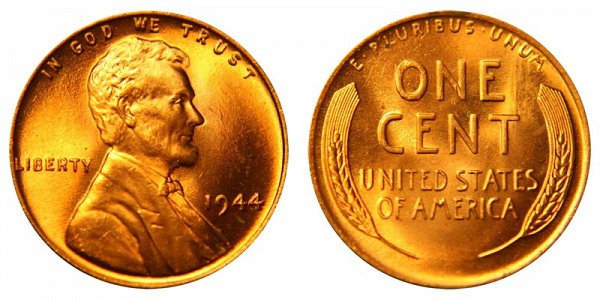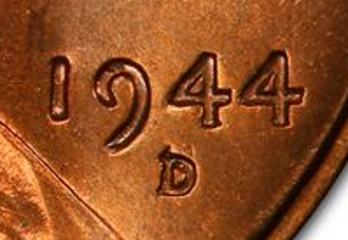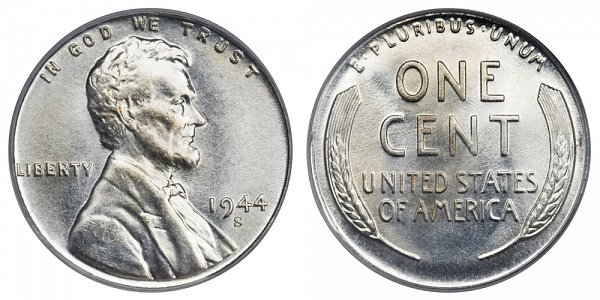1944 Lincoln Wheat Penny Value Guide
More than 2 billion wheat pennies were made in 1944, but that doesn’t mean that there aren’t important 1944 Lincoln cents that are worth a lot of money. In fact, the very valuable “twin” to the rare 1943 copper cent was born in 1944.

1944 Lincoln Wheat cent
How Much Is My 1944 Penny Worth?
If it’s a normal 1944, 1944-D, or 1944-S cent, it isn’t worth much. They are some of the most common of common-date Wheat cents. Prices range from around 20 cents in circulated condition, to 35 cents in uncirculated.
1944 Wheat Cent Mintages
| 1944 | 1,435,400,000 |
| 1944-D | 430,578,000 |
| 1944-S | 282,760,000 |
| TOTAL | 2,148,338,000 |
1944-D/S Wheat Cents
One rare 1944 Wheat cent to watch out for is the 1944-D/S. These pennies were made at the Denver Mint from a die that accidentally had an S mintmark (for San Francisco) punched into them. The S was buffed out and replaced with a D mint mark for Denver. Traces of the S can still be seen above the top edge of the D mint mark.

Close-up of the overpunched mint mark on a 1944-D/S RD (PCGS Coinfacts)
With over 430 million 1944-D Wheat cents minted, it is estimated that tens of thousands of 1944-D/S error coins exist. With even a worn example fetching over $100, it’s well worth your time to check any 1944-D cents using a magnifying glass.
1944-D vs 1944-D/S Wheat Cent Values
| MS65 | $2 | $715 |
| MS64 | $0.60 | $488 |
| MS63 | $0.40 | $422 |
| MS62 | $0.30 | $370 |
| MS61 | $0.27 | $358 |
| MS60 | $0.25 | $338 |
History of the 1944 Wheat Cent
More Wheat cents were made in 1944 than any other year -- more than 2.1 billion across all three Mints. This record would not be broken until 1960, when 2,167,289,000 Lincoln Memorial cents were produced.
Due to a shortage of tin, only copper and zinc were available to make Wheat cents from 1944 to 1946. Technically, the lack of tin meant that these coins were made of brass, not bronze.
This was still far better than the previous year, when the War Production Board refused to let the US Mint have any copper at all, forcing them to make Lincoln cents out of zinc-coated steel.
Did You Know?
A long-term spike in tin prices forced the US Mint to make Lincoln cents with just copper and zinc again from 1962 to 1982.
WWII "Shell Casing" Cents: Fact or Fallacy?
Debates have swirled over whether shell casings were used to make Wheat cents in 1944 through 1946. The speculation began almost as soon as the coins were released. Some consider the use of shell casings in the production of one-cent coins to be an urban myth, or a patriotic publicity stunt.
Roger W. Burdette was perhaps the foremost numismatic historian of our era. He discovered documentation in the National Archives confirming the use of shell casings to make Lincoln cents when researching his book United States Pattern and Experimental Pieces of WWII. These sources describe railroad hopper cars full of shell casings arriving at the Philadelphia Mint.
Separately, I uncovered Congressional testimony to the same effect. It proves that shell casings were in fact used to make Lincoln cents from 1944 through 1946.
In December 1943 testimony before a House Appropriations Subcommittee[1], Assistant Director of the Mint Leland Howard said:
“The War Production Board has granted us sufficient virgin copper and shell casings to resume production of a copperhued cent on January 1.”
“When we start producing the bronze coins -- and incidentally we have already started, as far as the production of blanks and ingots are concerned -- we will have to take the virgin copper, shell casings, and zinc-alloy them, melt them and pour them, roll the ingots into strips, and then blank the strips out; and all that cost will be borne by this appropriation, and it will eat into it at a rapid rate. It is necessary to use virgin metal with the shell casings. Our equipment will not work shell casings as they are. That is a 70-30 alloy -- 70 percent copper and 30 percent zinc -- our equipment will not handle that.”
“Shell casing” Wheat cents can sometimes display a brighter color than a normal bronze cent. Others can show streaks of color where minute traces of gunpowder primer made it through the cleaning process and into the alloy of a coin blank. These in particular are noted for their increased eye appeal.
1944 Steel Wheat Cent

1944-S Steel cent
1944 marked the end of the emergency WWII production of the 1943 steel penny. These zinc-coated steel Wheat cents were a stop-gap measure to keep the US economy from seizing up while the Mint looked for alternatives.
Much like the famous 1943 copper Wheat cents that were made when leftover copper blanks were accidentally run through the coin presses during the production of steel pennies, the 1944 steel Wheat cents were made when leftover steel blanks got mixed in with the brass “shell casing” blanks.
There are an estimated 20 to 30 surviving 1944 steel cents struck at the Philadelphia Mint, many in poor condition. Seven to ten 1944-D steel cents struck at the Denver Mint are thought to still exist, but only two 1944-S steel cents are known.
The reason there are so many 1944 steel cents from the Philadelphia Mint is that 25 million leftover 1943 zinc-coated one-cent steel blanks were used in 1944 to make an emergency issue of 2-Franc coins for liberated Belgium. This allowed for many more chances for a steel blank to find its way into the Wheat cent production line.
1944 Steel Cent Auction Records
| 1944 | $180,000 (MS64) |
| 1944-D | $115,000 (MS63) |
| 1944-S | $408,000 (MS66) |
1944 "Silver Penny"
Sometimes, steel cents were referred to as “silver pennies,” due to their color. Of course, there was no silver content in these coins; just steel and zinc. However…
A number of 1944 Wheat cents were struck on dime blanks! These coins of course retain a silvery color. They can be spotted by the absence of the edge features of the Lincoln cent design.
There are other, very rare, silvery “wrong-planchet” 1944 Lincoln cents out there that you might stumble upon, if you’re lucky. Examples include Wheat cents struck on a Netherlands 25 cent planchet (64% silver) that is almost exactly the correct size for a penny; and some struck on a Philippines 5 centavos silver-colored planchet made of 65% copper, 23% zinc and 12% nickel!
[1] Hearings Before the Subcommittee of the Committee on Appropriations House of Representatives Seventy-Eighth Congress Second Session On The Treasury Department Appropriation Bill for 1945 pp. 590-591 “Problems and Costs of Coining One-Cent Pieces” December 8, 1943
Read more expert analysis of Lincoln cent prices and penny collecting from the authors at Gainesville Coins:
Lincoln Wheat Penny (1909–1958): Values & Key Dates
1943 Steel Penny Value: How Much They Are Worth Now
What Is the Value of a 1943 Copper Penny?
What Are the Different Penny Errors and What Are They Worth?
US Mint Claims 1974-D Aluminum Cent
Rare Lincoln Penny Exceeds $1 Million in Sale

Steven Cochran
A published writer, Steven's coverage of precious metals goes beyond the daily news to explain how ancillary factors affect the market.
Steven specializes in market analysis with an emphasis on stocks, corporate bonds, and government debt.
